Physical Address
304 North Cardinal St.
Dorchester Center, MA 02124
Japanese encephalitis virus (JEV), a mosquito-borne flavivirus, is the leading recognized cause of childhood encephalitis in Asia. Although safe and effective vaccines are available, several thousand cases of Japanese encephalitis (JE) are reported annually. Because JE is not under comprehensive surveillance while diagnostic capacity is limited, official reports from many JE-endemic countries undoubtedly underestimate the true number of cases. , Substantial progress has been made in recent decades in the prevention and control of JE due to the availability of highly effective vaccines and the implementation of JE immunization programs. Yet, JE remains a major public health problem.
Summer-fall encephalitis outbreaks consistent with JE were recorded in Japan as early as 1871. , In 1933, Hayashi intracerebrally inoculated monkeys with emulsions of brain tissues from five patients who died during an outbreak in western Japan that year, and the monkeys developed neurologic illness. In 1935, JEV was first isolated. , , The source was a 19-year-old male who died from encephalitis and based on the patient's last name was called Nakayama strain JEV. This strain was later used in vaccine development. The capacity for diagnostic confirmation of JEV infections led to identification of cases elsewhere in the region, including a case in an American acquired in China. The virus initially was called Japanese B encephalitis to distinguish the disease from von Economo type A encephalitis, which had different clinical and epidemiologic characteristics; the modifying “B” has since fallen into disuse. The mosquito-borne mode of JEV transmission was confirmed with the isolation of JEV from Culex tritaeniorhynchus mosquitoes in 1938. Subsequent field studies established the role of pigs and aquatic birds in the viral enzootic cycle ( Fig 35.1 ).
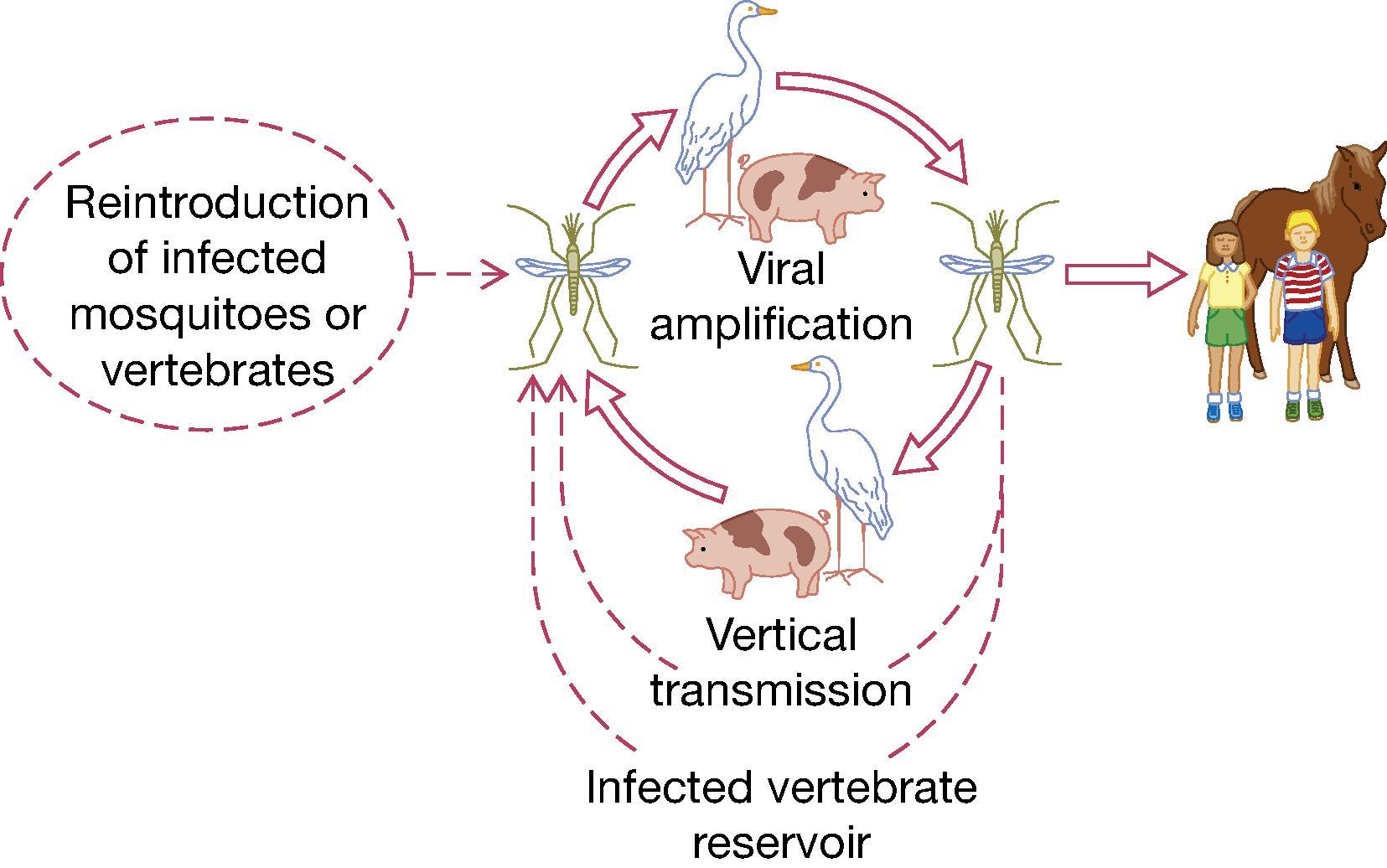
During the first half of the 20th century, JE was recognized principally in temperate areas of Asia with perennial outbreaks in Japan, Korea, and China. In Japan and Korea, outbreaks frequently resulted in several thousand cases. , In these countries JE also had a substantial impact on U.S. servicemen, especially in Korea where approximately 300 cases among military personnel were recorded in 1950. , In China, reporting of JE cases began in 1951, and many provinces recorded outbreaks in the early 1950s. , From 1965 through 1975, more than 1 million cases were reported, almost 175,000 in 1971 alone, and until the 1990s, 20,000 to 40,000 cases were recorded annually. , Since widespread use of JE vaccine in Japan from 1967, Taiwan from 1968, and Republic of Korea from 1983, JE epidemics have not occurred in these countries ( Fig 35.2 ). , , JE vaccine also played a major role in reducing national JE incidence in China after its wider use beginning in the late 1980s ( Fig 35.3 ).
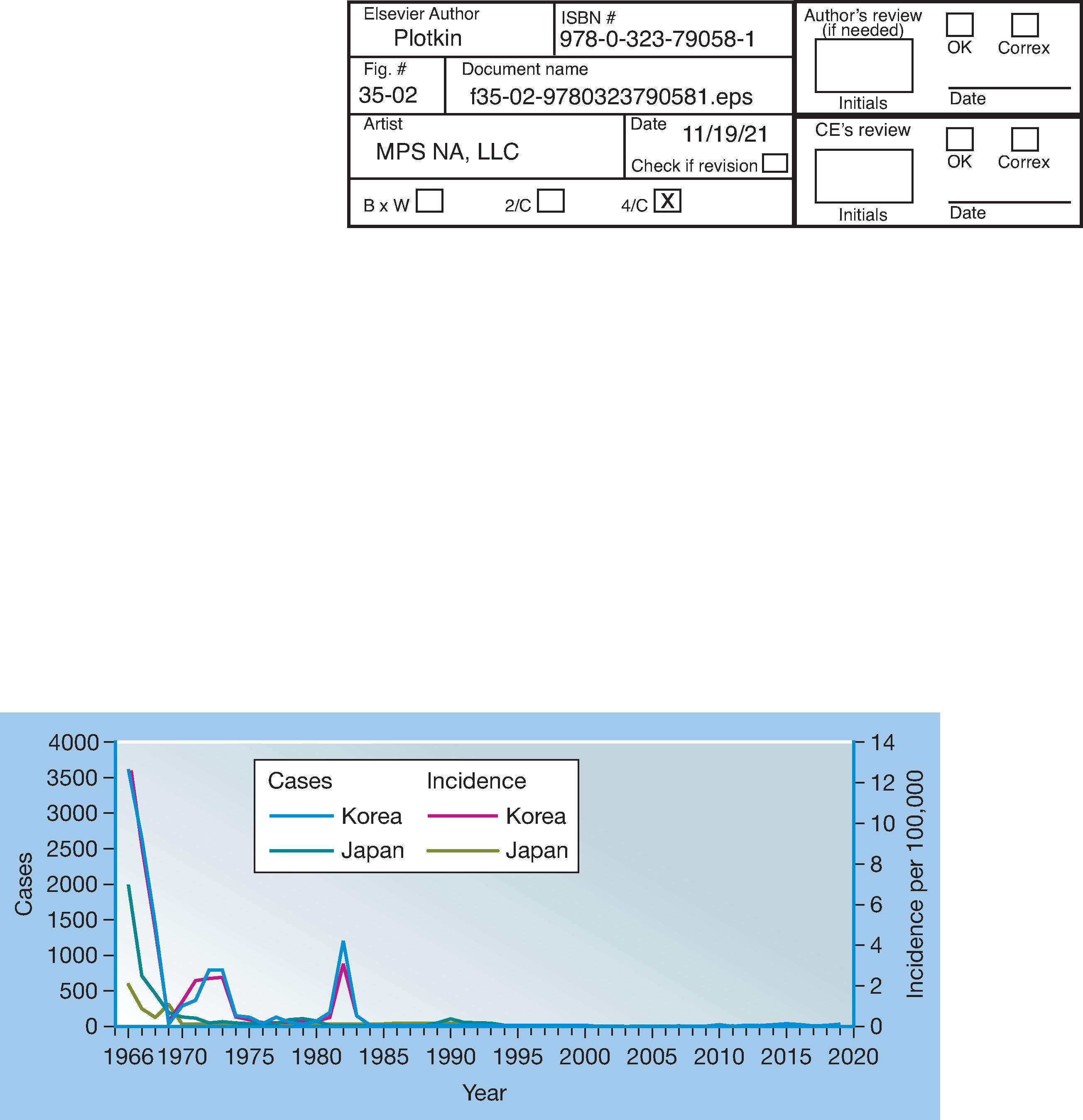
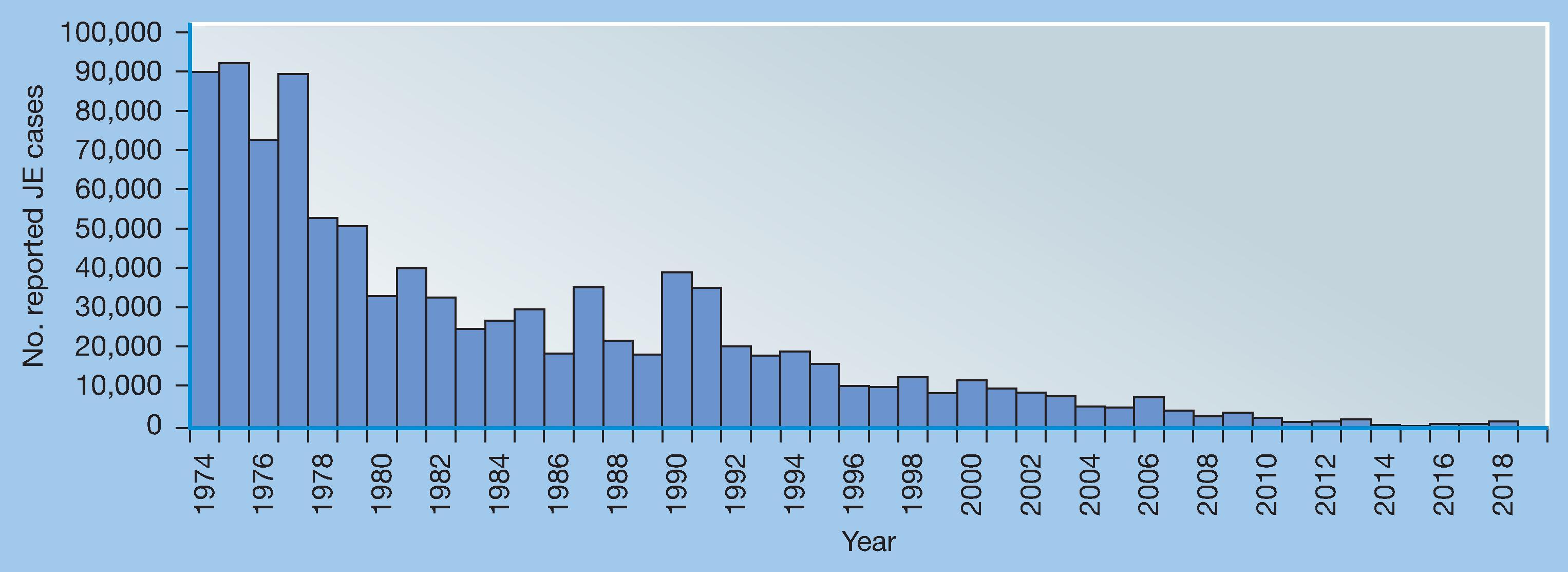
In Southeast Asia, although sporadic viral encephalitis cases were noted from early in the 20th century, JE was not recognized as a major public health problem until 1969, when an epidemic was reported from the Chiang Mai Valley in northern Thailand. The occurrence of yearly outbreaks in the northern region ultimately led to introduction of a JE vaccination program. , Myanmar (Burma) recorded its first epidemic in 1974 in an area adjacent to the Chiang Mai Valley, and several outbreaks followed. , In Vietnam, epidemics in the subtropical north occurred in the late 1960s and during the 1970s. , During the 1970s, JE was also recognized as an important cause of encephalitis in the Philippines, Malaysia, and Singapore. Subsequently, there was increased recognition of the disease burden from JE throughout Southeast Asia.
In South Asia, the first recognition of the disease was in India with confirmation of its presence coming from serosurveys in 1952, serologically confirmed clinical cases in 1955, and isolation of JEV from the brain of a fatal case in 1958. , The disease was initially only reported from southern India until 1973 when a large outbreak occurred in West Bengal in the eastern region of the country. Nepal experienced its first JE epidemic in 1978 in the southern Terai region along the Indian border, although sporadic cases had been reported prior to that time. Although virus was isolated in Sri Lanka in 1968 and endemic transmission had occurred for many decades, the first major outbreak occurred in 1985. , Bangladesh reported a small outbreak in 1977, but following that the disease was not recognized and no systematic assessments occurred until 2003. , In the west, JEV has spread as far as the Indus valley in Pakistan.
In the western Pacific region, self-limited outbreaks occurred on the islands of Guam in 1947–1948 and Saipan in 1990. During the 1990s, southward extension of the geographical range of JEV transmission was noted when cases occurred in northern Australia. JE cases were first reported in the outer Torres Strait Islands in 1995, and a case was detected on Cape York Peninsula on the northern mainland of Australia in 1998. , No locally acquired cases were subsequently reported until 2021 when a case was reported from the Tiwi Islands. However, in 2022, JEV transmission was detected much further south on the Australian mainland, with cases reported from four states (Queensland, New South Wales, Victoria, and South Australia).
JEV is the most common vaccine-preventable cause of encephalitis in Asia, transmitted in a region supporting more than half of the world's population. Each year, an estimated 67,900 JE cases occur, with children representing approximately 75% of these cases. 3 Epidemics frequently occur and can result in thousands of cases in a single season. Approximately 20–30% of patients with JE die, and 30–50% of survivors have neurologic, cognitive, or behavioral sequelae. , There is no antiviral treatment available to mitigate the effects of JEV infection, and disease outcome is often severe. Residents of rural areas are most often affected, and the economic impact from medical and other costs for families in these areas who are often from lower socioeconomic classes can be substantial. Given these factors, JE is a major public health problem.
JE vaccination has had a substantial impact on disease burden. One assessment estimated that forecasted JE vaccination programs in Gavi-supported low- and middle-income countries from 2001 to 2020 would prevent 300,000 JE cases, 59,000 deaths, and 67,000 cases of long-term disability. Considering the averted costs of illness, the broader economic and social value of JE vaccination was 4.2 billion US dollars. Despite progress, introduction or expansion of vaccination programs are still needed in many countries. Additionally, as the disease will never be eradicated owing to JEV's enzootic transmission, high-quality vaccination, and surveillance programs must be maintained long term.
The great majority of infections are inapparent, with only one in approximately 250 infections resulting in encephalitis in susceptible Asians, with higher overt infection rates in non-Asian populations. The principal recognized clinical manifestation of illness is acute encephalitis. , , Milder clinical manifestations, such as aseptic meningitis and febrile illness, can also occur. , , Patients occasionally present with a poliomyelitis-like acute flaccid paralysis. In some JE patients, the first manifestations can be abnormal behavior or acute psychosis, potentially leading to misdiagnosis; during the Korean War, some American soldiers were initially thought to have “war neurosis.” Rare conditions associated with JEV infection have included acute transverse myelitis, Guillain-Barré syndrome, and probable chorioretinitis and acute disseminated encephalomyelitis.
The incubation period is 5–15 days. Illness usually begins with non-specific symptoms which might include fever, headache, vomiting, diarrhea, and generalized weakness. During the next few days, mental status changes, motor dysfunction, and/or movement disorders develop. Seizures are very common among pediatric patients but are less frequent in adults. They can sometimes occur with subtle manifestations like twitching of a digit, eye deviation, or irregular breathing. , , Many patients become comatose and some require ventilatory assistance. Generalized weakness and changes in muscle tone, especially hypertonia and hyper-reflexia, are common, but focal motor deficits, such as paresis, hemiplegia, tetraplegia, or cranial nerve palsies (especially central facial palsy) also may be present. Sensory disturbances are less frequent. Extrapyramidal features, including tremor, a mask-like facies with wide unblinking eyes, cogwheel rigidity, and choreoathetoid movements, are characteristic of JE. , , Central hyperpnea, hypertension, pulmonary edema, and urinary retention may complicate the illness.
In patients whose main presentation is poliomyelitis-like acute flaccid paralysis due to anterior horn cell damage, the typical clinical course is a brief febrile illness followed by rapid onset of flaccid paralysis in one or more limbs without any alteration in consciousness. , Weakness is usually asymmetric and is more common in the lower than upper limbs. Encephalitis subsequently develops in about 30% of these patients, with an altered level of consciousness and upper motor neuron signs.
A poor prognosis has been associated with deep obtundation, multiple seizures, flexor and extensor posturing, abnormal respiratory patterns, and pupillary and oculocephalic reflex abnormalities. , , , Conditions that compromise the integrity of the blood-brain barrier, such as neurocysticercosis, appear to increase the risk for neuroinvasion and poor outcome.
Certain JE-associated abnormalities can often be detected with neuroimaging studies. Magnetic resonance imaging (MRI) is the best means for detecting these features, which might include abnormalities in the thalamus, basal ganglia, midbrain, pons, or medulla. Thalamic lesions are the most characteristic finding, and can be highly specific for JE in the appropriate clinical context, but are not a very sensitive marker of JE ( Fig 35.4 ).
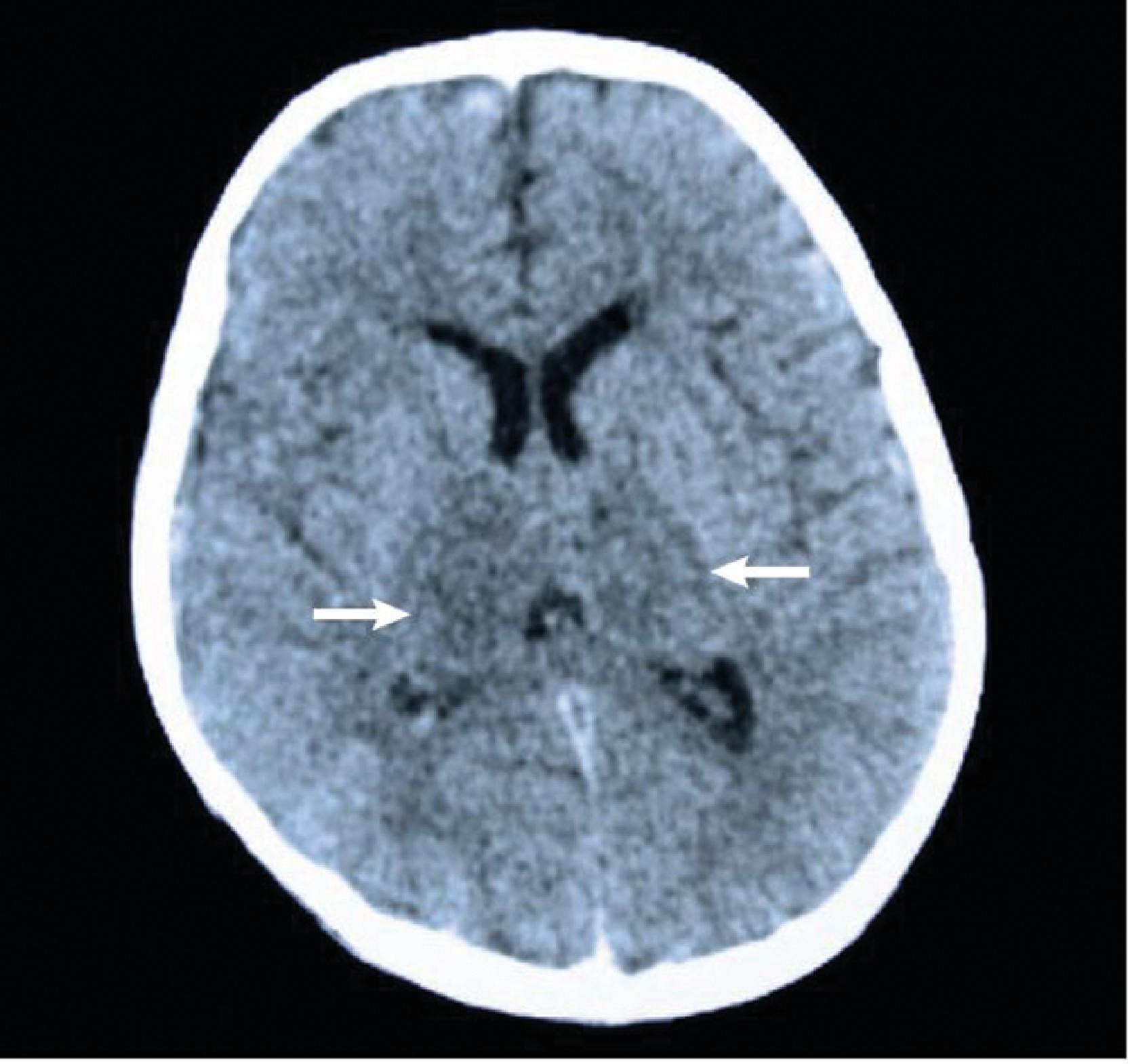
Recurrent neurologic symptoms and signs have sometimes been observed weeks to months after recovery from JE. , , In some cases, new lesions have been detected with MRI. Some evidence indicates JEV can persist for many months in peripheral blood mononuclear cells and in the central nervous system (CNS). ,
Reported case-fatality and disability rates vary greatly. The percentage of JE cases which are fatal ranges from 8% to 35% in various reports. , , , , Some deaths occur after a brief prodrome and fulminant course lasting a few days, whereas others occur after a more protracted course with persistent coma. Severity may vary by age. Several studies have indicated that children, especially those younger than 10 years of age, are more likely than adults to die, and, if they survive, their neurologic deficits are often more severe. , , , , However, other studies have found adults can have similar or higher rates of death and certain severe sequalae compared to children. , Disability rates vary widely, with study findings showing persistent sequelae in 35% to 65% of patients within the first year and in 30% to 80% of patients up to 10 years later. , , , , , , , , , However, differences in reported rates partly reflect comprehensiveness of the follow-up examination including the approach to the measurement of cognitive and neurologic sequelae, whether calculations were based on the total patient cohort or survivors, and the proportion of the original cohort able to be located at follow-up.
Principal sequelae fall into three main categories: psychosocial, intellectual, and physical. Deficits can include memory loss, impaired cognition, behavioral disturbances, emotional lability, seizures, motor weakness or paralysis, and abnormalities of tone and coordination. Over time, abnormalities can improve or eventually resolve. , , , , , However, some sequelae can worsen and new abnormalities can develop; in a study in China, some patients developed neurologic abnormalities, namely optic nerve degeneration and seizures, 3 to 17 years after acute infection. ,
JEV is one of more than 70 viruses in the Flavivirus genus of the Flaviviridae family. , Morphologically, flaviviruses are spherical, positive, single-stranded RNA, approximately 40–50 nm in diameter, with a lipid membrane enclosing a nucleocapsid core. Membrane surface projections are composed of a glycosylated envelope (E) and membrane (M) protein, a mature form of the premembrane (prM) protein. The JE viral RNA, 10,976 bases long, contains an uninterrupted open reading frame, flanked by 5' and 3' untranslated regions, encoding a polyprotein which is cleaved into three structural proteins and seven nonstructural (NS) proteins. ,
Flaviviruses replicate in a variety of cultured cells of vertebrate and arthropod origin. Viral entry occurs by receptor-mediated endocytosis, with the formation of coated vesicles, or by direct fusion with endosomal membranes. The nucleocapsid is uncoated by acid-dependent fusion of viral and endosomal membranes, releasing genomic RNA into the cytoplasm where viral replication occurs. The translated polyprotein then is processed and assembled into a virus-specific replication complex.
The JE serological group comprises eight antigenically related virus species and two subtypes. The virus species are JE, Cacipacore, Koutango, Murray Valley encephalitis, St Louis encephalitis, Usutu, West Nile, and Yaounde viruses, with Alfuy and Kunjin viruses being subtypes of Murray Valley and West Nile viruses, respectively.
JEV is divided into five genotypes (Gs) which are thought to have originated from a common ancestral virus in the Indonesia-Malaysia region ( Table 35.1 ). GIII has been responsible for numerous JE epidemics and was the most frequently isolated genotype throughout most of Asia until the 1990s. However, GI has now displaced GIII as the predominant genotype in many Asian countries and has been detected from India in the west to Australia in the south ( Fig 35.5 ). A possible explanation for the displacement of GIII by GI is an observed increase in the in vitro multiplicative ability of a GI virus in mosquito cells, suggesting an increase in the efficacy of transmission cycles in nature.
| Genotype | Country (Year[s] of Isolation) |
|---|---|
| I | Cambodia (1967) |
| Thailand (1971, 1979, 1982, 1984, 1992) | |
| Korea (1991, 1993, 1994) | |
| II | Malaysia (1968, 1970) |
| Indonesia (1978, 1981) | |
| Thailand (1982, 1983) | |
| Australia (1995) | |
| III | Japan (1935, 1957, 1959, 1979, 1982, 1992) |
| China (1949, 1954, 1955) | |
| Taiwan (1958, 1972, 1987) | |
| India (1958, 1963, 1970, 1975, 1978, 1982) | |
| Vietnam (1962, 1964–1988) | |
| Thailand (1964, 1982) | |
| Sri Lanka (1969, 1987) | |
| Philippines (1977, 1984) | |
| Indonesia (1979) | |
| Korea (1983, 1984, 1987) | |
| Nepal (1985) | |
| IV | Indonesia (1980, 1981) |
| V | Singapore (1952) |
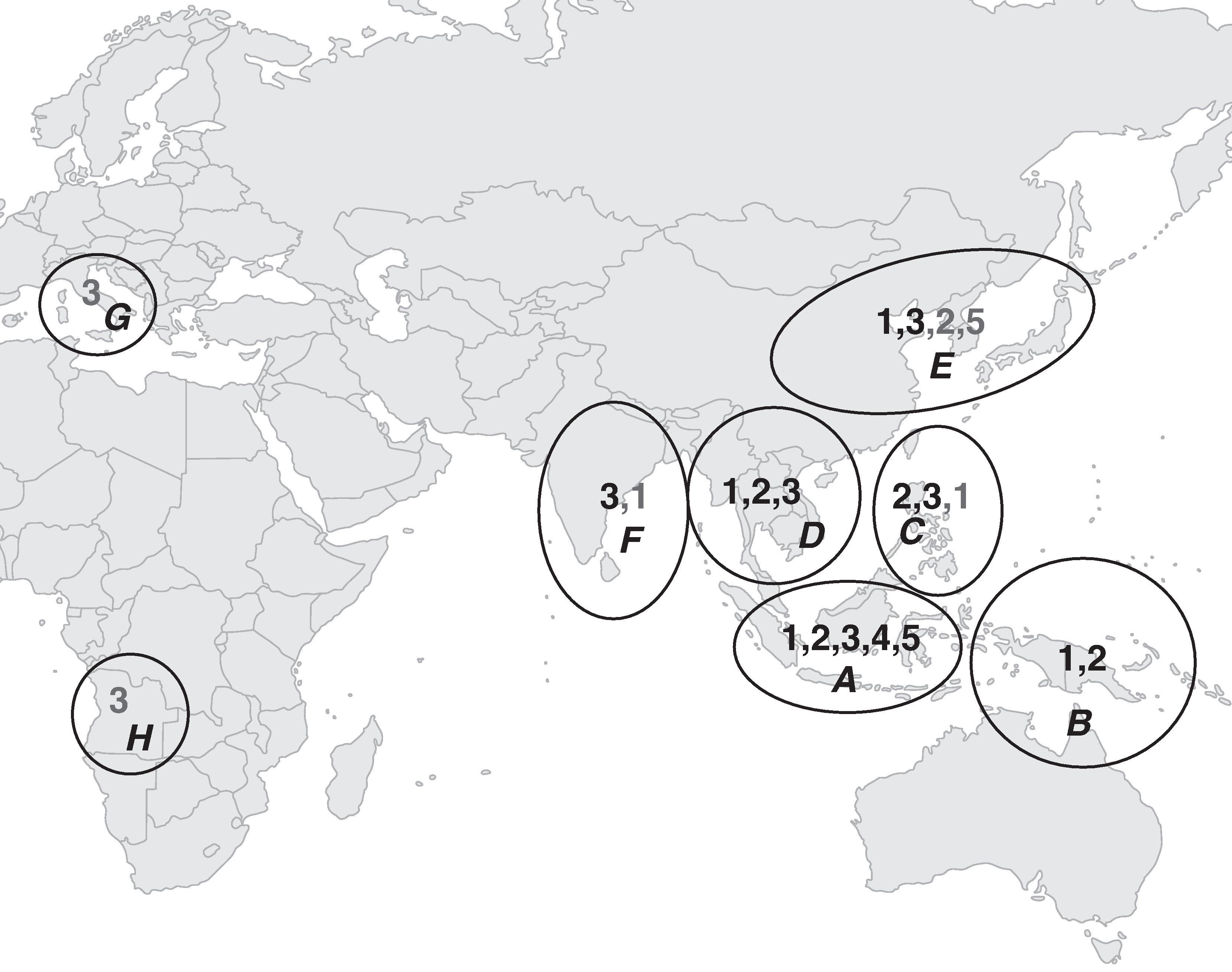
Antigenic variation has been recognized using polyclonal and monoclonal antibodies. Polyclonal sera analyses differentiated two major immunotypes, represented by the prototype Nakayama strain and by the Beijing-1 strain. Monoclonal antibody analyses have demonstrated at least five antigenic subgroups. However, there is thought to be just one serotype of JEV. JEV isolates from the same region but from different years show a high degree of nucleotide similarity. ,
After an infectious mosquito bite, virus is thought to replicate in Langerhans dendritic cells in the skin which carry virus to regional lymph nodes where further viral replication occurs. , A brief, low-level viremia then ensues, following which the virus spreads into the CNS, probably across the vascular endothelium of the blood-brain barrier. Data from a blood-brain barrier model suggest viral replication in the vascular endothelium disrupts the tight junctions of the barrier to allow inflammatory cells and virus across. On entry to the CNS, the virus primarily targets neurons. The inflammatory response that is stimulated results in recruitment of macrophages and lymphocytes to the perivascular space, parenchyma, and CNS. ,
Cerebral edema and congested leptomeninges are visible on gross examination of the brain, and “punched-out” necrolytic lesions in the gray matter may be seen. , Histopathologic examination discloses perivascular inflammation, microglial proliferation, and neuronophagia. , , Viral antigen is distributed principally in the thalamus, midbrain, hippocampus, and temporal cortex. ,
Circulating antibody has a critical role in modulating infection by limiting viremia in the preneuroinvasive phase. Experimentally infected monkeys immunosuppressed with cyclophosphamide had no measurable antibody response and exhibited increased susceptibility to encephalitis. Clinically, high CSF interferon-α levels and low CSF virus-specific immunoglobulin (Ig) M and IgG antibodies have been associated with a fatal outcome. , Recovered patients develop antibodies to structural and NS proteins and have CD4 and CD8 T memory lymphocytes.
Other studies suggest an important role for immunopathology in the pathogenesis of JE. Antibodies to neural antigens (neurofilament and myelin basic protein) were associated with death, suggesting that neural damage resulted in a destructive autoimmune response. CSF viral immune complex formation also was associated with mortality, further implicating the possibility of autoimmune injury. High levels of inflammatory mediators are detected in patient CSF, and increasing concentrations of tumor necrosis factor (TNF) and IL-6 correlate with poor outcome. ,
Cell-mediated immune mechanisms have been described in athymic nude mice which, in contrast with normal adult mice, die or develop an extended illness with secondary viremias after peripheral inoculation. Antibodies did not appear in nude mice, indicating the functional importance of T-helper cells. Interestingly, although virus replicated to high titers in brain tissue, histopathologic evidence of encephalitis was absent, indicating that T cells are required in mediating pathologic changes. Memory T-cell responses in individuals who were asymptomatic after JEV exposure were found to be predominantly CD8+ whereas in individuals who had recovered from JE they were mostly CD4+. An unbalanced CD4+ T-cell response, with TNF production but not IFNγ or IL 2 production, was associated with poor recovery.
There are no pathognomonic features of JE, and laboratory confirmation, usually by serologic tests, is necessary. The most widely used serologic test is the enzyme-linked immunosorbent assay (ELISA) for detection of JEV-specific immunoglobin IgM antibodies in CSF or serum. JEV-specific IgM antibodies might not be detectable on hospital admission in the CSF of up to 30% of patients and in the serum of up to 45% of patients, but the majority of patients have IgM detectable in CSF by 4–6 days after symptom onset and in serum by 7–8 days after onset. , If JE is suspected and acute samples are negative, a convalescent serum sample should be collected. The presence of JEV-specific IgM antibodies in CSF provides evidence that JEV is the cause of neurologic illness. IgM antibody in serum is suggestive of JE but could indicate asymptomatic infection or recent JE vaccination. With clinical and epidemiologic correlation, a positive IgM test has good diagnostic predictive value, although cross-reactivity with other flaviviruses can occur. , ,
Plaque reduction neutralization tests (PRNTs) are used to measure virus-specific neutralizing antibodies and to discriminate between cross-reacting antibodies in primary flavivirus infections. , Recent JEV infection can be confirmed by a fourfold or greater rise in virus-specific neutralizing antibodies between acute- and convalescent-phase serum specimens. In patients who have been infected previously with another flavivirus (i.e., who have secondary flavivirus infections) or have been immunized with a flaviviral vaccine (e.g., yellow fever, dengue, or tick-borne encephalitis vaccines), cross-reactive antibodies may make it difficult to identify which flavivirus is causing the patient's illness. Vaccination history, date of symptom onset, and information regarding other flaviviruses known to circulate in the geographic area that might cross-react in the assay should be considered when interpreting results. Routine access to PRNTs is limited in many countries in Asia, except through the World Health Organization (WHO) JE laboratory network. ,
Virus isolation or detection of viral RNA with a nucleic acid amplification test (NAAT) can provide a definitive diagnosis, but neither virus isolation nor detection of viral RNA by a NAAT is sufficiently sensitive for routine diagnostic purposes. , , Positive results from blood or CSF are uncommon. , , Viremia in humans is low level and transient, and neutralizing antibodies are generally present by the time distinctive clinical symptoms are recognized. In rare cases, virus or RNA has been recovered from urine or throat swabs. If postmortem brain tissue is available, isolates can sometimes be obtained or JEV antigens can be detected by immunohistochemistry. , , ,
No specific therapy is available, but supportive treatment can substantially reduce morbidity and mortality. Good nursing care and close attention to managing ventilation, fluids, and nutritional status, and prevention of secondary infections, contractures, and pressure sores can improve outcome. Aspiration pneumonia is a particular concern in any patient with a reduced gag reflex. Medications and other modalities might be needed to control intracranial pressure, maintain adequate cerebral perfusion, manage extrapyramidal symptoms, or to control seizures. In controlled clinical trials, patient outcomes were not improved with corticosteroids, interferon alpha-2a, ribavirin, minocycline, or intravenous immunoglobulin ( Table 35.2 ). However, many of the studies were underpowered for detection of improvements in outcomes. In all trials combined, fewer than 400 patients with confirmed JE have been enrolled, and many potential treatment approaches that might have benefit remain untested. ,
| Treatment Under Investigation | Trial Location | No. Patients Randomized | No. Patients with Confirmed JE | Result | Reference |
|---|---|---|---|---|---|
| Dexamethasone (0.6 mg/kg loading dose and 0.2 mg/kg every 6 hours for 5 days) versus placebo (saline) delivered intravenously | Thailand | 65 | 55 | No statistically significant benefit of treatment on mortality through 25 days, days to alert mental status, or neurologic status at 3 months after discharge | |
| Interferon alpha-2a (10 million units/m 2 daily for 7 days) versus placebo (sterile water) delivered intramuscularly | Vietnam | 117 | 87 | No significant difference in percentage of children in treatment and placebo groups with poor outcome at discharge (death or severe sequelae) or severe sequelae at 3 months post discharge. | |
| Ribavirin (10 mg/kg per day in 4 divided doses for 7 days) versus placebo (syrup) delivered through nasogastric tube or by mouth | India | 153 | 153 | No significant difference between treatment and placebo groups in early (in-hospital) mortality rate or secondary outcome measures (outcome at hospital discharge, time to resolution of fever, time to resumption of oral feeding, duration of hospitalization, or outcome at ≥3 months after hospital discharge) | |
| Minocycline (5–6 mg/kg in 2 divided doses for 10 days) versus placebo (sugar capsule) through feeding tube | India | 44 | 44 | No significant difference between treatment and placebo groups in mortality rate at discharge or prevalence of neurological deficits and behavioral problems at 12 months post discharge. Significant reduction in mean duration of fever, unconsciousness, and hospital stay in treatment group | |
| Minocycline (loading dose of 5 mg/kg/day followed by 2.5 mg/kg 12 hourly in children ≤12 years and 200 mg loading dose followed by 100 mg 12 hourly in patients >12 years) versus placebo (powder without active ingredient) delivered orally or through a nasogastric tube |
India | 281 | 29 * | No significant difference between treatment and placebo groups in mortality or overall outcome at 3 months post discharge | |
| Intravenous immunoglobulin containing anti-JEV neutralizing antibody (400 mg/kg/day for 5 days) versus placebo (saline) delivered intravenously | Nepal | 22 | 13 | No statistically significant difference in outcome (death or neurologic sequelae) between treatment and placebo groups at discharge or at follow up at 3–6 months |
* Trial investigated minocycline use in patients with acute encephalitis syndrome, including JE.
JEV is transmitted throughout most of Asia and parts of the western Pacific ( Fig 35.6 ). Each year several thousand JE cases are reported to WHO, with some fluctuation from year to year, but official figures undoubtedly underestimate true incidence ( Fig 35.7 ). In 2010, an assessment based on review of population-based JE surveillance studies estimated that 67,900 JE cases occur annually, including 13,600 to 20,400 deaths and 14,300 to 27,200 cases with long term sequelae. Overall incidence was estimated at 1.8 JE cases per 100,000 population, and with approximately 75% cases occurring in children aged 0–14 years, the estimated childhood JE incidence was 5.4 per 100,000 children. In several developed Asian countries (i.e., Japan, Taiwan, and Korea), JE has been controlled and currently fewer than 50 cases typically are reported annually ( Fig 35.2 ). , , A substantial decline in incidence also has occurred in other countries in recent decades, including Thailand, Nepal, China, Malaysia, Vietnam, and Sri Lanka. , The major contributing factor to the decrease has been immunization. Substantial progress has been made with introduction and strengthening of JE immunization programs in Asia, and as of 2021, 16 (64%) of the 25 countries in the JEV transmission risk area have at least a subnational immunization program. , In some areas, other factors probably have contributed to the decline, including industrialization and urbanization reducing Culex breeding sites, widespread use of agricultural pesticides, and centralized pig production. , ,
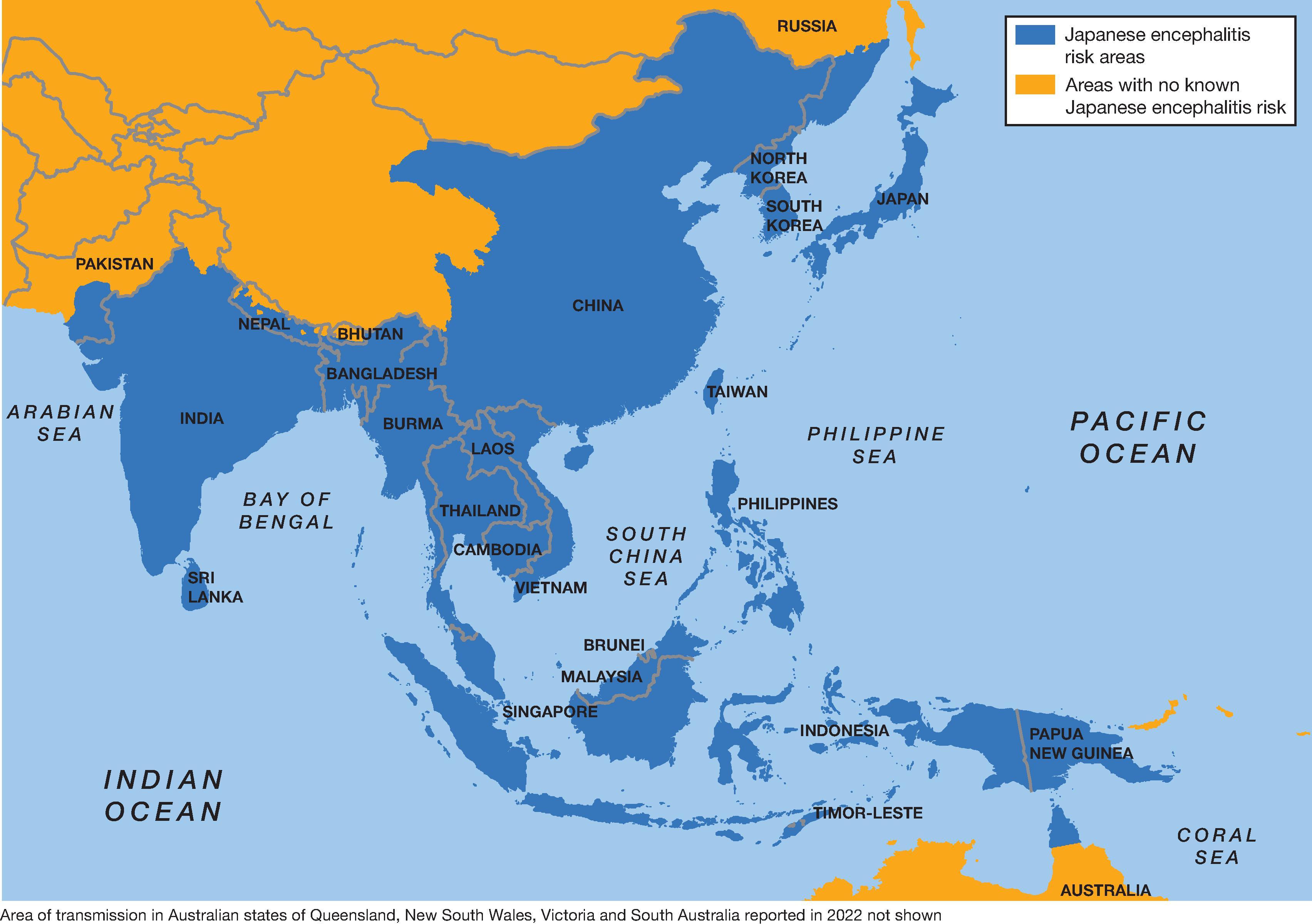
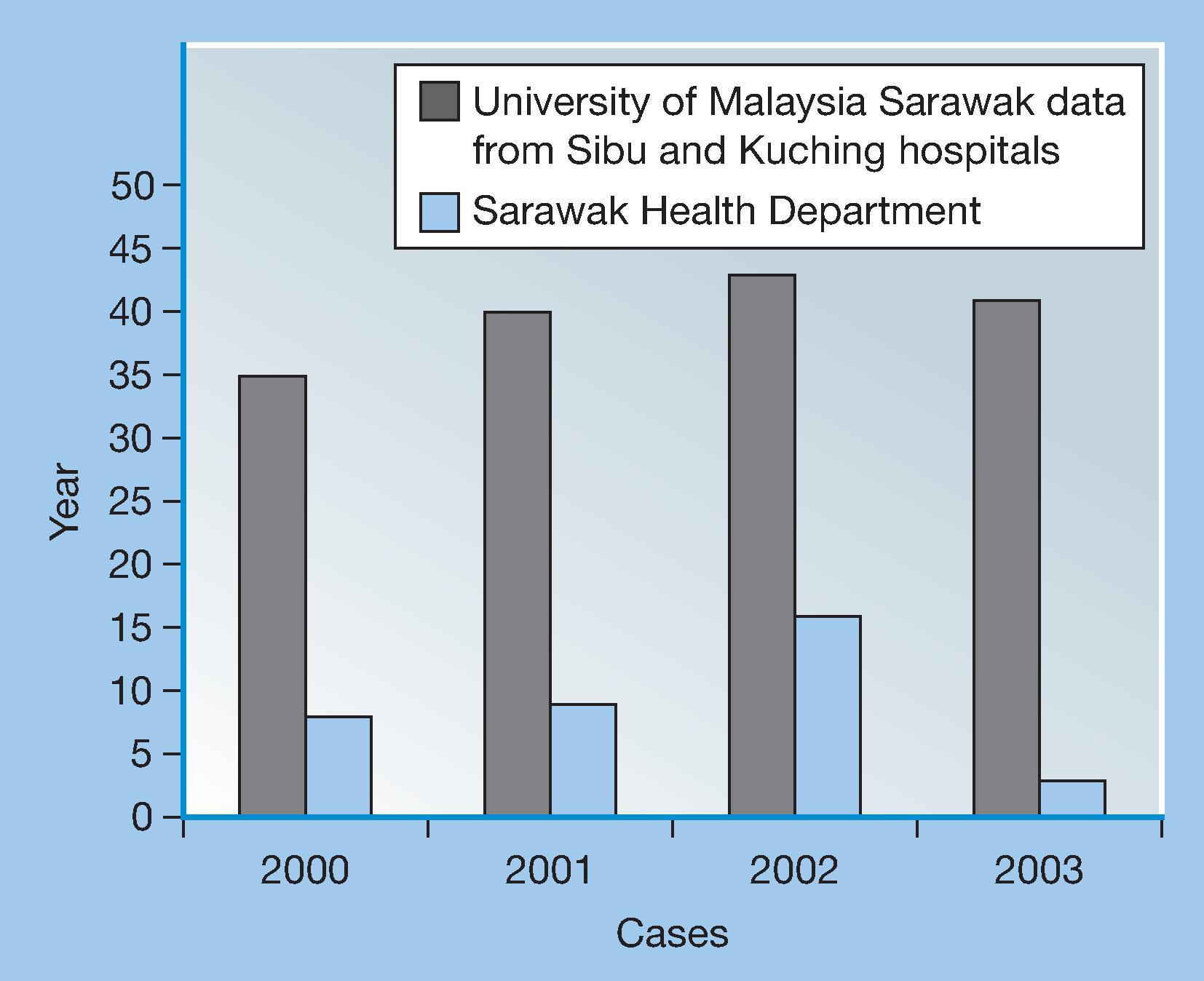
In locations where childhood cases have been prevented by immunization, including in Japan, Korea, Taiwan, parts of India, and some locations in China, the age distribution of cases has shifted toward adults, particularly to elderly people. , , , , This shift does not necessarily mean an increase incidence in older populations. Often, with higher immunity levels among younger persons, it simply reflects an increase in the proportion of cases in adults. Waning vaccine-induced immunity, immunosenescence in the elderly, and reduced opportunities for natural exposure and “boosting” infections in urban populations are probable contributing factors to cases among older persons. In Assam, India, a predominance of adult cases resulted in implementation of an adult vaccination program. If such programs are under consideration, factors including disease incidence and cost-effectiveness and feasibility of adult immunization programs need to be assessed.
JE is principally a disease of rural areas. Risk factors for acquiring JE vary regionally, but proximity to rice fields, pig ownership, lack of air conditioning, and household crowding, have been identified in some studies. , JE risk is highest in children younger than age 15 years, as most adults have acquired natural immunity after childhood infection ( Fig 35.8 ). , , Although risk for acquiring JEV infection is greatest in rural areas, conditions that permit enzootic viral transmission exist at the periphery of many Asian cities, and sometimes even within urban centers. , JE cases in persons residing in urban areas have been reported from many places, including occasionally from suburban areas of major cities such as Bangkok, Beijing, Tokyo, Hong Kong, Singapore, and Delhi. , , , , , Previously, areas with high Muslim populations were believed not to be at risk because pig rearing is rare, and there was a strong perception that pigs were an essential part of the JEV transmission cycle. However reporting of serologically confirmed JE cases across widespread areas of Indonesia and Bangladesh, predominantly Islamic countries, have demonstrated this notion is incorrect ( Fig 35.9 ) , ,
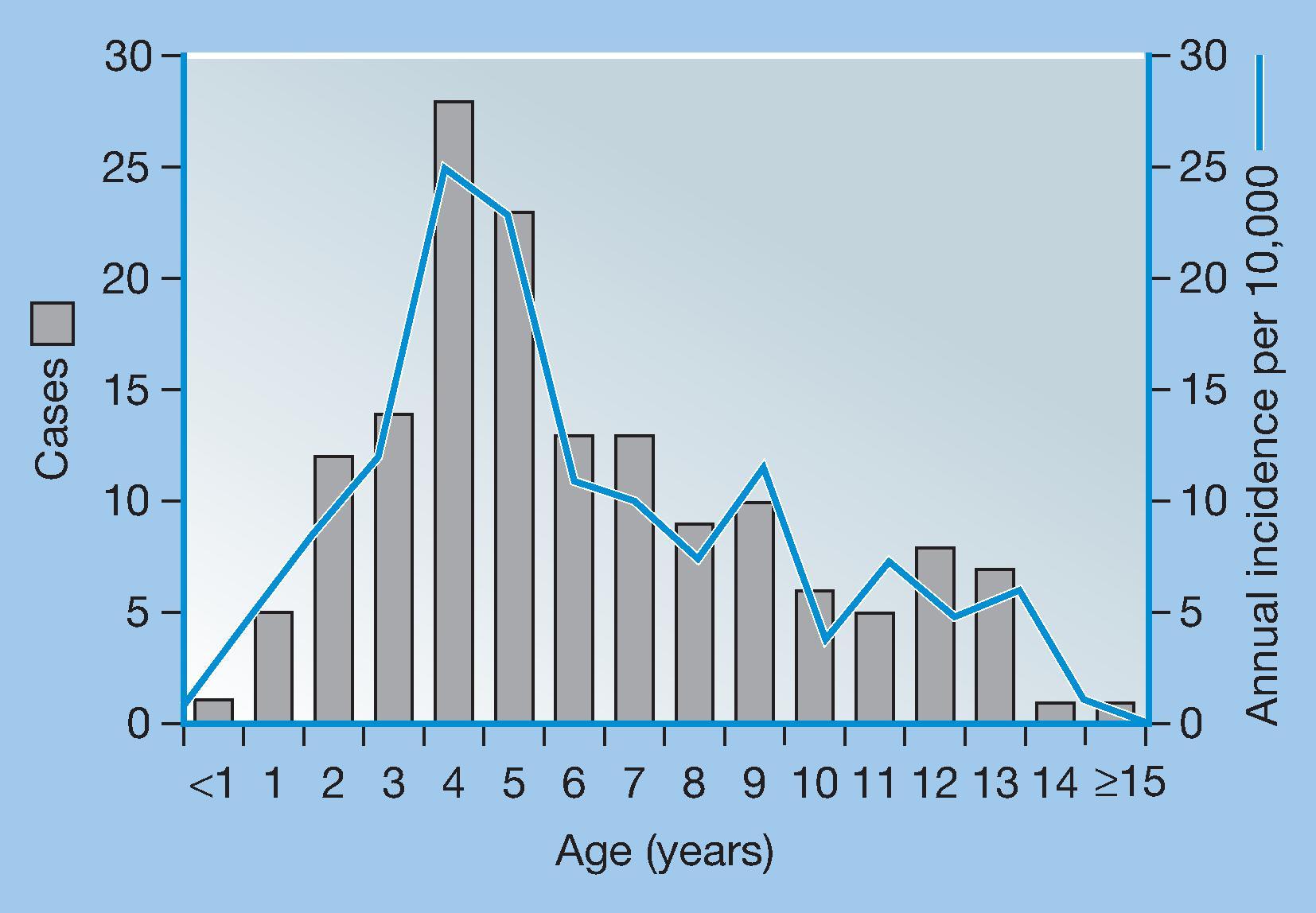
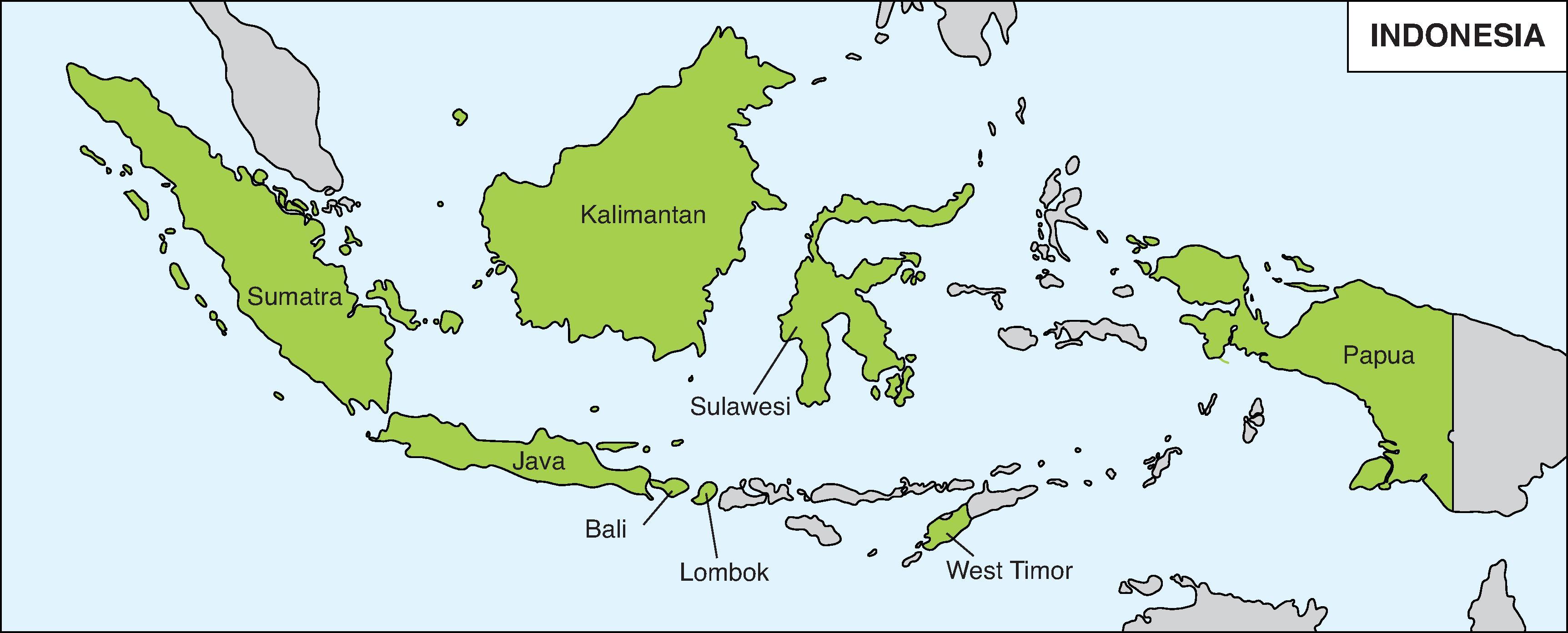
Although JE vaccines are used principally in Asia to protect local populations, vaccines also are important for travelers visiting JEV transmission risk areas ( Table 35.3 ). During 1973–2017, 85 cases of JE were reported among citizens of 20 nonendemic countries who had traveled to JE-endemic areas, although reported cases undoubtedly underestimate the true number of cases. , , Among the 85 reported cases, 53 (62%) cases occurred in tourists, 17 (20%) in expatriates (defined as residents through a transmission season), and 6 (7%) in military personnel; the type of travel was unknown in nine (11%) cases. The median age of patients was 36 years (range: 5 weeks to 91 years). The endemic countries where JE was most commonly acquired included Thailand (n = 26), Indonesia (n = 13), the Philippines (n = 11), and China (n = 9). While Thailand and Indonesia had the highest number of cases, they are also destinations with high numbers of tourists. , Among the 85 patients, 14 (16%) died and 39 (46%) had mild to severe sequelae. None of the cases were known to have received JE vaccine. No cases occurred among business or other shorter-term travelers who visited only urban areas.
| Country | Risk Area | Transmission Season | Local Vaccination Program | Comments |
|---|---|---|---|---|
| Australia | Outer Torres Strait Islands, parts of four states on mainland (New South Wales, Queensland, South Australia, Victoria) | December–May | Targeted populations (outer Torres Strait Islands) | Four cases reported from Outer Torres Strait Islands in 1995 (n=3) and 1998 (n=1). 1 case reported from Tiwi Islands in 2021. On Australian mainland, 1 case reported in 1998 from Cape York in far northern Queensland and cases reported in 2022 in eastern and southern states |
| Bangladesh | Widespread | Year-round with most cases reported July–November | No | Highest disease incidence in northwest Bangladesh |
| Bhutan | Presumed widespread in nonmountainous areas | Unknown | No | Risk likely highest in southern districts |
| Brunei Darussalam | Presumed widespread | Unknown | Private market | Limited data but outbreak reported in 2013 |
| Cambodia | Widespread | Year-round with peak season May–October | Yes | Cases reported from most provinces |
| China | Enzootic throughout country except Xinjiang and Qinghai. No human cases reported from Tibet but serologic testing suggests human infections have occurred. Rare cases in Hong Kong | Northern China: May–September; Southern China: April–October | All affected provinces | Vaccine not routinely recommended for travelers to major cities; highest JE rates in Guizhou, Shaanxi, Sichuan, and Yunnan Provinces, and Chongqing City |
| India | Andhra Pradesh, Arunachal Pradesh, Assam, Bihar, Goa, Haryana, Jharkhand, Karnataka, Kerala, Maharashtra, Manipur, Meghalaya, Nagaland, Odisha, Punjab, Tamil Nadu, Telangana, Tripura, Uttar Pradesh, Uttarakhand, West Bengal | Peak season May–November, especially in northern India; the season may be extended or year-round in some areas, especially in southern India | All affected districts | Highest rates reported from West Bengal, Bihar, Karnataka, Kerala, Tamil Nadu, Andhra Pradesh, Assam, Uttar Pradesh, Haryana, and Goa |
| Indonesia | Enzootic throughout country | Year-round, with peak period coinciding with rainy season and variable by island | Bali only | Sentinel surveillance has identified human cases in Bali, Kalimantan, Sumatra, Sulawesi, Java, Lombok, West Timor, and Papua. Several traveler cases reported from Bali |
| Japan | Enzootic throughout country | June–October, except Ryukyu Islands (Okinawa), April–October | Yes | Vaccine not routinely recommended for travelers to major cities |
| Korea, North | Presumed to be enzootic throughout country | Unknown. Proximity to South Korea suggests May–November | Sporadic campaigns | |
| Korea, South | Enzootic throughout country | May–November | Yes | Vaccine not routinely recommended for travelers to major cities |
| Laos | Enzootic throughout country | Year-round with peak June–September | Yes | |
| Malaysia | Enzootic throughout country | Year-round, with peak season in Sarawak from October–December | Yes (routine in Sarawak) | Most human cases reported from Sarawak |
| Myanmar (Burma) | Enzootic throughout country | Year-round with most cases reported May–September | Yes | Greatest risk in delta and lowland areas |
| Nepal | Southern lowland (Terai); some cases reported from Kathmandu Valley and other hill and mountain districts | June–October | Yes | Highest rates of disease reported from western Terai districts; vaccine not routinely recommended for those trekking in high-altitude areas |
| Pakistan | Unknown | Unknown | No | |
| Papua New Guinea | Enzootic through most of country | Year-round | No | |
| Philippines | Enzootic throughout country | Year-round with peak season April–August | Yes | |
| Russia | Enzootic in Far Eastern provinces | June–September | No | Cases previously reported from Primorsky Krai. Vaccine not routinely recommended |
| Singapore | Little transmission | Year-round | No | Vaccine not routinely recommended |
| Sri Lanka | Enzootic throughout country | Year-round with peak season November–February | Yes | Highest rates of human disease reported from Anuradhapura, Gampaha, Kurunegala, Plonnaruwa, and Puttalam districts |
| Taiwan | Enzootic throughout country | May–October | Yes | Vaccine not routinely recommended for travelers to major cities |
| Thailand | Enzootic throughout country | Cases occur year-round in south; May–October in north | Yes | Several traveler cases reported from resort and coastal areas of southern Thailand |
| Timor-Leste | Presumed widespread | No data. Proximity to West Timor suggests year-round |
No | |
| Vietnam | Enzootic throughout country | Year round with peak season May–October, especially in the north | Yes | Highest disease rates in the northern provinces |
| Western Pacific | Sporadic introductions, most recent in Saipan in 1990 | Unknown | No | Vaccine not recommended |
a Risk can vary from year to year and within areas, so caution should be used in making assessments using these data. Information based on published and unpublished reports, including from: Hills SL, Lindsey NP, Fischer M. Japanese encephalitis. In: CDC Yellow Book 2020: Health Information for International Travel. New York, NY: Oxford University Press; 2019:248–57. For any updates, refer to the U.S. Centers for Disease Control and Prevention, Travelers' Health ( http://wwwnc.cdc.gov/travel ).
The risk for acquiring JE during travel is highly variable but is very low for most travelers to Asia. , For U.S. travelers in the 25-year period from 1993–2017, there were 12 JE cases reported and approximately 4–5 million U.S. citizen trips to Asia each year. , Using these figures, risk can be calculated as less than one case per million trips to Asia. Studies that have investigated the frequency of subclinical JEV infection among travelers also support the low risk for most travelers. Among 1000 unvaccinated U.S. infantry based in Korea for at least 330 days during 2008–2011, serologic testing prior to and after deployments suggested only one possible infection. No JEV infections occurred among 387 Australian travelers who visited Asia for a median of 21 days and had not been vaccinated prior to departure. However, risk varies based on travel destination, duration, season, activities, and lodgings ( Table 35.4 ). A longer period of travel increases the risk for exposure to infected mosquitoes, and persons who stay for extended periods in rural areas with active JEV transmission might have a risk level similar to that of the susceptible resident population. Supporting this idea, eight (67%) of the 12 U.S traveler cases from 1993–2017 had traveled for ≥1 month, despite only approximately 20% of U.S. travelers to Asia traveling for >30 days. , Therefore, two-thirds of U.S. JE cases occurred among the 20% of higher-risk, longer-term travelers. Shorter-term travelers also might have a high risk of infection depending on their planned itinerary, particularly if extensive outdoor or nighttime exposure to mosquitoes occurs. , Cases have been reported in travelers with brief itineraries staying in coastal areas or resorts located in or adjacent to rural or rice growing areas. ,
| Risk Factors |
|---|
Duration
|
Season
|
Location
|
Activities
|
Lodging
|
Other
|
| Protective Factors |
|
Two main patterns of JEV transmission are recognized. In temperate areas, seasonal or epidemic transmission occurs which typically peaks in the summer or fall. , , , The peak transmission months and season length vary regionally and can differ from year to year. , Large, explosive outbreaks can occur and result in thousands of cases. In tropical regions, year-round endemic transmission occurs, and often intensifies following monsoon rains with the possibility of two transmission intervals in a calendar year. , , , , In subtropical areas (e.g., northern Thailand), the two patterns can overlap with epidemic activity superimposed on endemic transmission.
JEV is maintained in nature in an enzootic transmission cycle involving vector mosquitoes and amplifying vertebrate hosts, primarily pigs and wading birds such as herons or egrets ( Fig 35.1 ). , , Domestic pigs are considered the most important vertebrate hosts because they are often kept nearby human dwellings, have high-level viremias, and produce many offspring, enabling the population of susceptible hosts to be replenished regularly. , , , There has been much speculation about how JEV persists in JEV risk areas with low winter temperatures, and more than one mechanism might play a role. JEV can probably overwinter in infected mosquitoes, and vertical transmission may contribute to virus survival. , , Long-term persistence in tissues and blood of JEV-infected vertebrate hosts, such as bats and reptiles, has been demonstrated, suggesting possible survival in hibernating animals. , In some areas, annual reintroduction of the virus by viremic migratory birds or by windblown mosquitoes may also occur. ,
Humans can develop illness when bitten by an infected mosquito, but are considered incidental, dead-end hosts because they do not develop a level or duration of viremia sufficient to infect mosquitoes. , Similarly, horses can develop neurologic illness but are also considered dead-end hosts. ,
Culex tritaeniorhynchus is the principal JEV vector in most areas of Asia, and Culex annulirostris is the primary vector in Australia. , Other species might be important locally, such as Culex gelidus, Culex vishnui , Culex fuscocephala , Culex bitaeniorhynchus, Culex pseudovishnui , Culex whitmorei , Culex annulus , Anopheles subpictus , Aedes togoi , Ochlerotatus japonicus , and Mansonia uniformis . , JEV has been isolated from many other mosquito species, but not all are considered competent to transmit the virus. The major Culex vectors are ground pool– and rice paddy–breeding mosquitoes that bite during the night, particularly during the crepuscular (twilight) periods at dawn and dusk. , They mainly feed outdoors, and are chiefly zoophilic, preferring to bite animals rather than humans. , , While meteorologic factors generally influence vector abundance and human risk for infection, the increased frequency of irrigated rice agriculture in many areas has impacted vector bionomics. , Paddy flooding schedules influence mosquito numbers, as flooded fields can be intense sources of breeding and can produce more than 30,000 adults mosquitoes in a day, and vector abundance can peak at any time of the year, including during the dry season.
JEV infections in pigs and birds are asymptomatic. However, if pregnant sows are infected, they can abort or have stillborn offspring. Other animals, such as cattle, buffalo, dogs, sheep, goats, and rodents may become infected but they fail to develop sufficient viremia to support further viral amplification. , Immunization of pigs prevents abortion and stillbirths and may reduce viral transmission by nullifying the role of pigs as viral amplifiers, although pig immunization programs have not always been successful. , Pig vaccination is also expensive, not easily reproducible with the high birth rates in the swine population, and is impossible to implement in settings where pigs forage freely, a common practice in low-resource areas. In addition, pigs are not essential for ongoing JEV risk, because birds can efficiently maintain transmission when pigs are not contributing substantially to transmission. , , , , Outbreaks have occurred on islands where pigs are not present, such as Langkawi, Malaysia.
Other modes of transmission have been documented on rare occasions. In India, JEV was isolated from an aborted fetus, suggesting that intrauterine transmission of JEV can occur. , JEV transmission through blood transfusion has been documented, and based on experience with similar flaviviruses, organ transplantation is also considered a potential mode of transmission. , At least 22 laboratory-acquired JEV infections have been reported in the literature. Transmission in the laboratory setting could occur through percutaneous exposures, and potentially by mucosal or inhalational exposures, especially from preparations containing high viral concentrations which occur during viral purification.
JEV has increased in geographic range in recent decades, with new areas of transmission recognized most recently in Tibet, at higher altitudes in Nepal, and in 2022, in southern and eastern states of Australia. Factors that could result in further expansion in the JEV transmission area include the ongoing increases in rice cultivation and pig farming, and possibly environmental changes related to climate change. , , Viremic migratory birds or windblown mosquitoes are other possible mechanisms of JE viral importation over longer distances, and are hypothesized to have led to outbreaks on Saipan and northern mainland Australia. , A small number of reports have described possible JEV presence in Africa and Europe. During a yellow fever outbreak in 2016 in Angola, a patient was diagnosed clinically with yellow fever but high-throughput sequencing indicated co-infection with yellow fever virus and JEV. In Italy, RNA fragments consistent with JEV genome were detected in seven dead birds and the bone marrow of four healthy birds collected from 1997–2000 and in one pool of Culex pipiens mosquitoes collected in 2010. Testing of samples from 38 patients with meningoencephalitis in the period following, and in the same area as, detection of the positive mosquito pool did not indicate any evidence of JEV infection. The significance of these reports is unclear, and further data are required to confirm JEV circulation outside of the Asia-Pacific region.
Notwithstanding the achievements made in the introduction and strengthening of JE immunization programs, JE remains the leading cause of vaccine-preventable encephalitis in Asia, and multiple challenges to its control remain. Not only is timely expansion of vaccination needed, but because JEV is maintained in an enzootic cycle and viral eradication from nature is not possible high-quality childhood immunization programs must be sustained. This is well illustrated in Japan, where regular viral surveillance using sentinel pigs and horses continues to document ongoing JEV transmission ( Fig 35.10 ). , Few human cases are reported in Japan because of high vaccination coverage, but when the recommendation for JE vaccination was temporarily suspended in 2005, vaccination rates in young children declined and two unvaccinated children with JE were subsequently reported in 2006 and 2009. , , The recommendation for routine childhood vaccination was reinstated in 2010.
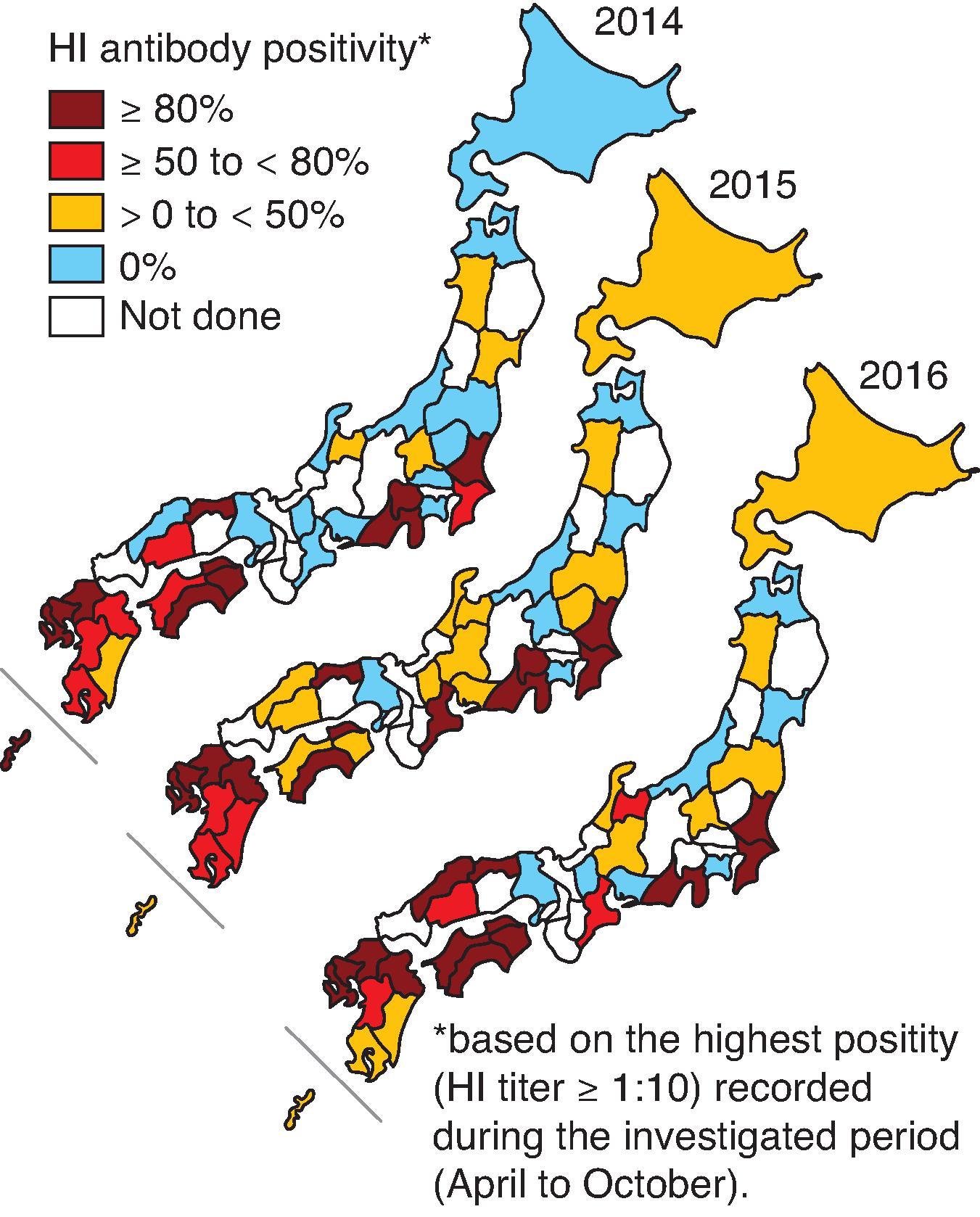
JE immunoglobulin is not available for prophylaxis.
Worldwide, at least seven different types of JE vaccines are produced and used, some in several countries ( Table 35.5 ). For many years, only inactivated JE vaccine produced in mouse brain was available in most countries. Biken, a Japanese manufacturer, distributed this product abroad for many decades, but production was discontinued in 2005. The three vaccines currently most widely available internationally are the live attenuated SA14-14-2 JE vaccine produced by Chengdu Institute of Biological Products (CDIBP), China; the inactivated Vero cell-derived JE vaccine manufactured by Valneva Scotland Ltd and licensed by Valneva Austria GmbH, Austria; and the live attenuated chimeric JE vaccine manufactured by Government Pharmaceutical Organization–Merieux Biological Products Co. (GPO-MBP Co., a joint venture between GPO and Sanofi Pasteur), Thailand. Following technology transfer from Valneva, Biological E produced a similar Vero cell-derived JE vaccine in India, and in July 2013 this was the first JE vaccine to be prequalified by the WHO, with its initial indication limited to use in adults aged 18–49 years. In October 2013, the live attenuated SA14-14-2 JE vaccine was the first JE vaccine to be prequalified for children. Prequalification subsequently followed for the chimeric JE vaccine in 2014, and the Biological E Vero cell-derived vaccine for use in children aged 1 to <3 years in 2015. The age range for the Biological E product was subsequently extended and it is now prequalified for children and adults aged 1–49 years. Information presented here will focus on these three vaccines that are widely available internationally and WHO prequalified. Vaccines in national, or limited regional, use will be briefly described later in the chapter.
| Vaccine Type | Substrate | Viral Strains | Manufacturers |
|---|---|---|---|
| Inactivated | Vero | SA14-14-2 | Austria: Valneva Austria GmbH; India: Biological E |
| Vero | Beijing-1 | Japan: Biken (Research Foundation for Microbial Diseases of Osaka University), Kaketsuken (The Chemo-Sero-Therapeutic Research Institute) Korea: Boryung Pharmaceutical Co., Ltd (fill-finish of Kaketsuken vaccine) |
|
| Vero | Beijing P-3 | China: Liaoning Chengda Biotechnology Co | |
| Vero | Kolar strain (JEV 821564XY) | India: Bharat Biotech | |
| Mouse brain | Nakayama | Vietnam: Vabiotech | |
| Live attenuated | Hamster kidney cells | SA14-14-2 | China: Chengdu Institute of Biological Products, Wuhan Institute of Biological Products |
| Chimeric, live attenuated | Vero | JE SA14-14-2/yellow fever 17D | Thailand: Government Pharmaceutical Organization-Merieux Biological Products Co.; Sanofi Pasteur |
The wild-type parental virus, SA-14, was isolated from a pool of Culex pipiens larvae from Xian, China, following 11 passages in mouse brain. The derivation of the strain SA14-14-2 was performed through an empirical process of serial passage performed in Beijing, China, and the strain was designated SA14 clone 14-2 (also designated SA14-14-2) ( Table 35.6 ). At the Walter Reed Army Institute of Research (WRAIR), the SA14 clone 14-2 was first adapted to primary dog kidney (PDK) cells and then to Vero cells. Attenuated SA14-14-2 vaccine strain was initially passaged eight times in certified PDK cells, then the virus was passaged in certified Vero cells and used as the master seed for making the inactivated vaccine. Phase I and Phase II clinical trials were carried out at WRAIR, and the vaccine was then licensed to Intercell AG (now Valneva Austria GmbH) for further development. The vaccine was tested under the name IC51. In 2009 it was licensed for adults and in 2013 for pediatric use.
| Name | |
|---|---|
| Parental Japanese encephalitis SA14 virus isolated from pool of Culex pipiens larvae by 11 passages in mouse brain | SA14 |
| 100 serial passages in primary hamster kidney (PHK) cells followed by three plaque purifications | SA14-12-1-7 |
| Two plaque purifications | SA14-17-4 |
| One mouse spleen passage (intraperitoneal inoculation) followed by four plaque purifications | SA14-9 |
| One mouse skin passage (subcutaneous inoculation) followed by one plaque purification | SA14-9-7 |
| Six hamster spleen passages (oral inoculation) followed by two plaque purifications | SA14-5-3 |
| Five suckling mice skin passages (subcutaneous inoculation) followed by two plaque purifications | SA14-14-2 |
Inactivated Vero cell–derived SA14-14-2 vaccine contains no preservatives, antibiotics or stabilizers. The vaccine contains aluminum hydroxide at a concentration of 0.1% as an adjuvant. Other excipients include phosphate-buffered saline consisting of sodium chloride, potassium dihydrogen phosphate, disodium hydrogen phosphate, and water for injection. From the manufacturing process, the vaccine also contains formaldehyde (≤200 ppm), bovine serum albumin (≤100 ng/mL), host cell DNA (≤200 pg/mL), sodium metabisulfite (≤200 ppm), host cell proteins (≤300 ng/6 µg of protein), and protamine sulfate (≤1 µg/mL).
Working viral seed is produced at Valneva Scotland Ltd (Livingston, UK). The JE vaccine production seed is prepared by inoculating Vero cells grown in roller bottles. After virus inoculation and propagation, virus harvests are filtered, pooled, and concentrated. The concentrated virus pool is treated with protamine sulfate to remove Vero cell DNA. The virus pool is then purified by batch centrifugation in a sucrose gradient. The purified material, containing hemagglutinating virus, is inactivated with formaldehyde, which is then neutralized with sodium metabisulfite. Following neutralization, the inactivated virus is sterile filtered through 0.2 µm filters and diluted to a specified antigen content of 12 µg/mL. Finally, the preparation is adsorbed to 1.5 mg/mL aluminum hydroxide.
The vaccine is licensed and distributed under the trade name IXIARO in Europe, North America, Hong Kong, Singapore and Israel, while in Australia and New Zealand, the vaccine is licensed and distributed by bioCSL under the trade name JESPECT. Following transfer of the manufacturing technology for IC51, the Indian company Biological E produces a similar vaccine under the trade name JEEV at its facility in Hyderabad.
The vaccination dose and primary schedule vary by age. For adults and children 3 years of age and older, the dose is 0.5 mL. Each 0.5-mL dose contains 6 µg of JEV strain SA14-14-2 viral protein adsorbed on 0.25 mg Al3+ (hydrated aluminum hydroxide), corresponding to a potency of 460 ng ED50 (median effective dose) or less. For children 2 months through 2 years of age, each dose is 0.25 mL (3 µg of viral protein). The vaccine is supplied in a 0.5 mL prefilled glass syringe. Administration is by the intramuscular route. The primary series consists of two doses administered 28 days apart. For adults aged 18–65 years, an accelerated schedule with two doses administered 7 days apart can be used. The U.S. Advisory Committee on Immunization Practices (ACIP) indicates that in persons aged 18–65 years, the second dose can be given anywhere between 7 and 28 days after the first dose. If completion of the primary series is delayed, study data indicate a second dose given at up to 11 months after the first dose can provide a similar seroprotection rate compared with the standard 0 and 28 day schedule. Immunization with the primary two dose schedule should be completed at least 1 week before potential exposure to JEV. Protection after only one dose is limited, with seroprotection rates after a single dose only 25% (59 of 233 subjects) at day 10 and 41% (95 of 230 subjects) at day 28.
Persons who are at ongoing risk or likely to be re-exposed to JEV should receive a booster dose. The ACIP recommends a booster dose be given before re-exposure if ≥12 months have elapsed since completion of the primary series. The European Medicines Agency (EMA) recommends a booster dose at 12–24 months after primary immunization. No data are available on the response to a booster dose administered >2 years after the primary series. No U.S. recommendations currently exist on the need for subsequent booster doses, but the EMA recommends that for adults aged 18–65 years, a second booster should be given 10 years after the first booster.
Biological E's JEEV vaccine should be administered as a two dose series at an interval of 28 days. The need for a booster dose in endemic settings has not been clearly established and as of 2021 WHO does not recommend a booster dose.
No combination vaccines are available.
The vaccine should be stored at 35°F–46°F (2°C–8°C). It has an approved shelf life of 36 months.
Development of JE vaccines in China began in the 1960s. , An inactivated vaccine based on the Beijing P-3 JEV strain was the first licensed JE vaccine. It was used from 1968 until 2005 but had limited production capacity and required five doses administered up to the age of 10 years. In the 1970s, development of a live attenuated JE vaccine began, directed by Professor Yu Yongxin. Attenuated vaccine strains were developed from SA14, a wild-type JEV isolated in 1954. Attenuation was accomplished by serially passaging SA14 through animals and cell culture under variable physical conditions ( Table 35.6 ). Several potential candidates were identified before SA14-14-2.
Balancing reversion to virulence and over-attenuation in the selection of vaccine candidates was a major challenge. , For example, strain SA14-5-3 was no longer virulent, was immunogenic in mice, and did not revert to virulence after intracerebral passage in suckling mice. Among residents of JE-endemic areas, SA14-5-3 had seroconversion rates of 86%. However, in nonendemic areas, seroconversion rates were only 62%. Subsequent studies found this over-attenuation and low immunogenicity in flavivirus nonimmunes was related to four amino acid changes in the E protein. SA14-5-3 was licensed for production and roughly five million children were vaccinated, but an alternative with increased effectiveness was sought. Several candidate strains achieved attenuation but were unstable, reverting to virulence after intracerebral passage in suckling mice. To boost its immunogenicity, SA14-5-3 was further passaged in mice and primary hamster kidney (PHK) cells, resulting in SA14-14-2. SA14-14-2 strain was as attenuated as SA14-5-3 but had increased immunogenicity in humans. Unlike wild-type SA14, SA14-14-2 virus produced no mortality in mice or monkeys and resulted in minimal CNS inflammation. Phenotypic characteristics of the vaccine strain were stable through multiple additional passages.
In the early 1980s, China's National Institutes for Food and Drug Control transferred the vaccine technology to CDIBP for scaled up production in PHK cells, and, in 1988, SA14-14-2 was licensed in China. High-quality data on protective effectiveness were obtained in 1999 when 160,000 Nepalese children were given a single dose of SA14-14-2 vaccine just prior to a large seasonal outbreak of JE. A case-control study established a protective effectiveness of 99% that proved durable, with effectiveness still 96% at 5 years. Remarkably, the vaccine provided protection against JE even when administered during the ongoing outbreak.
In accordance with WHO technical specifications, the master seed virus of the SA14-14-2 JEV strain was screened for and shown to be free of adventitious agents including retroviruses at Q-One Biotech, United Kingdom. The primary hamster kidney cell line was certified pathogen free.
The major components of the vaccine are the SA14-14-2 virus, human serum albumin, gelatin, sucrose, lactose and carbamide. From the manufacturing process, the vaccine also contains residual gentamicin (≤50 ng) and residual bovine serum albumin (≤50 ng).
SA14-14-2 seed virus is maintained at China's National Institute for the Control of Pharmaceutical and Biological Products. Lyophilized seed is provided to two of China's vaccine production facilities, CDIBP and the Wuhan Institute for Biological Products, where it is passaged once to make the production (“working”) seed. PHK cells are obtained from 10- to 12-day-old golden Syrian hamsters maintained in pathogen-free colonies at CDIBP and Wuhan Institute for Biological Products. SA14-14-2 vaccine must meet WHO and Chinese pharmacopeia standards, so the master and working seeds undergo regular testing for neurovirulence, reversion to virulence, neuroinvasiveness, and adventitious agents. SA14-14-2 is inoculated onto PHK monolayers in glass roller bottles where the virus replicates for 3–4 days. After cultivation and harvest, appropriate stabilizers are added, and the virus suspension is lyophilized.
SA14-14-2 vaccine is produced for China's domestic use by CDIBP and Wuhan Institute for Biological Products and produced for international export by CDIBP. In 2013, CDIBP's SA14-14-2 vaccine was prequalified by WHO, making it eligible for use by WHO, UNICEF, and other United Nations-associated agencies as well as procurement using Gavi funds. , As of 2021, SA14-14-2 vaccine is licensed and distributed to the national immunization programs of ten countries (China, India, Thailand, Korea, Myanmar, Nepal, Laos, Cambodia, Sri Lanka, and Indonesia) (personal communication, Yan Lingjiang, CDIBP, 2020). In addition, the Philippines, Vietnam, and North Korea have received periodic shipments of SA14-14-2 vaccine over the past 10–15 years. CDIBP's vaccine is distributed under the trade names CD.JEVAX and RS.JEV.
The 2015 WHO position paper recommends that SA14-14-2 vaccine should be given as a single-dose (0.5mL) primary vaccination administered subcutaneously to children aged ≥8 months. Because protection for several years has been demonstrated for a single dose WHO does not currently recommend a booster dose. However, China, India, Thailand, and Korea have opted for a two-dose primary vaccination schedule. In China and India, a two-dose schedule provides a second opportunity for vaccination and is intended to ensure high coverage with at least one dose.
SA14-14-2 vaccine is produced as 1- and 5-dose products with a virus titer of ≥5.7 log PFU/mL (≥5.4 log PFU/dose). Lyophilized vaccine is reconstituted with sterile water (1-dose vial) or with phosphate buffered saline (5-dose vial). Because 5-dose vials do not contain a preservative, doses from 5-dose vials should be used within six hours of reconstitution.
No combination vaccines are available.
The current WHO-approved shelf-life for SA14-14-2 vaccine is 24 months at a storage temperature of 2–8°C. The vaccine should be stored and shipped at 2–8°C, protected from sunlight. The infectious titer of lyophilized vaccine is not appreciably changed after storage at 37°C for 7–10 days or at room temperature for 4 months. However, reconstituted vaccine is labile, and its infectious titer decreases significantly after 2 hours at room temperature. Reconstituted multidose vials should be used within 6 hours.
The live, attenuated chimeric JE vaccine is constructed from the yellow fever 17D genome that contributes NS genes and the SA14-14-2 genome that contributes prM and E genes ( Fig 35.11 ). The product was invented at St. Louis University, Missouri; developed by Acambis, Cambridge, Massachusetts; and licensed for global distribution to Sanofi Pasteur, Lyon, France. , The chimera is constructed from DNA, transcribed to RNA, and then used to transfect Vero cells. The resultant infectious clone has the attenuation properties of SA14-14-2 but Vero cell growth characteristics of yellow fever 17D. A mouse study of attenuation of the chimeric virus found that ≥2 amino acid reversions partially restored the neurovirulent phenotype and ≥4 reversions of three E protein clusters conferred full neurovirulence. , The single-dose vaccine (1 dose/vial) was licensed in Australia and Thailand in 2010, and multi-dose product (4 doses/vial) was approved for use in Thailand in 2012.
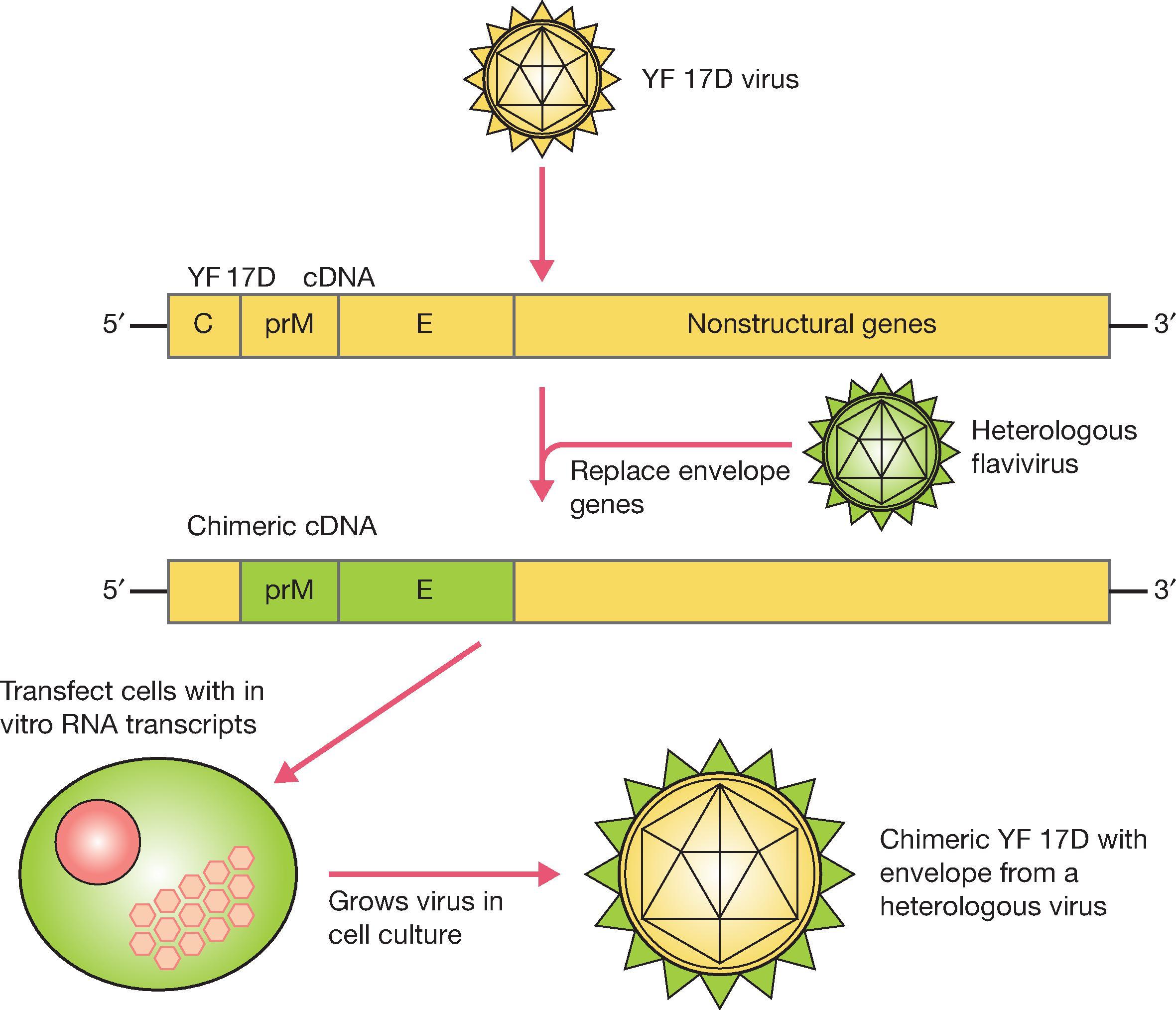
The vaccine contains no antimicrobial preservative or adjuvant. The stabilizer consists of mannitol, lactose, glutamic acid, potassium hydroxide, histidine, human serum albumin and sodium chloride.
Master and working seeds are derived from the recombinant DNA copy of the virus genome in accordance with WHO guidelines. The manufacturing process involves culture of Vero cells under serum-free and antibiotic-free conditions, viral inoculation and propagation, viral harvest, purification, and filtration.
Become a Clinical Tree membership for Full access and enjoy Unlimited articles
If you are a member. Log in here